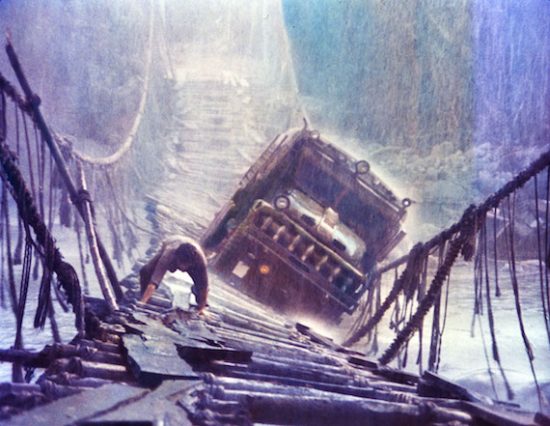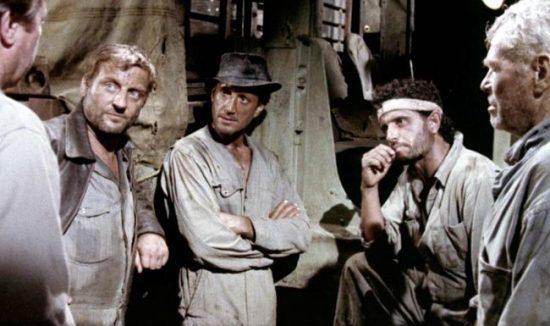Late To The Party: Sorcerer – “Brilliantly bold and heart-stopping”
Late To The Party is a series of reviews ranging from classical masterpieces to modern-day blockbusters where I look to make my confession for the sin of not having seen them before. I seek absolution from the film universe and hope to never again suffer your disdain for my film faux pas. I am Fredo, in the boat. Hail Mary, full of grace.
This week, the first time watch is William Friedkin’s 1977 adaptation of George Arnaud’s The Wages Of Fear, Sorcerer.
The film follows the story of four men from different parts of the world. The first is Nilo (Francisco Rabal) a hitman, who after an assassination in Mexico, goes on the run. The second is Kassem (Amidou), a Palestinian terrorist who detonates a bomb in Israel. His comrades are killed or captured by Israeli forces and he is the only one to escape. The third is Manzon (Bruno Cremer), a rich Parisian banker who is about to be publically accused of serious financial fraud and after his business partner commits suicide, he is forced to disappear. Finally, Jackie (Roy Scheider) who is a gang member and getaway driver involved in a botched robbery of a church where a priest is shot. The priest happens to be the brother of a powerful mob boss and Jackie is forced to leave the country and go on the run. All four men take refuge under assumed identities in the town of Porvenir in Latin America. The poverty is extreme and they all survive by working menial jobs in a town that exists to service and provide labour for a large American oil company involved in drilling in the area. When a fire breaks out at a separate drilling facility over 200 miles away, the men are employed to transport dynamite that has been stored incorrectly and is now beginning to sweat highly combustible and unstable nitro-glycerine. They are to transport the deadly material in trucks through rough jungle terrain in order for the fire to be blown out.
The film starts with a series of prologues establishing each of the four men and their reasons for being in the same place at the same time. This section accounts for approximately a quarter of the film and by the time the men are in the trucks, their characters and motivations have all been firmly established. Friedkin makes it clear that we are primarily following the story of Jackie, played by Roy Scheider who is magnificent as the hood on the run. His portrayal of Jackie, or Dominguez as he is now known, is one of the great anti-heroes and evokes memories of Cagney or Bogart, wearing a crumpled yet stylish hat, a two-day stubble and jungle sweat.
Before anyone has even sat in the cab of a truck, the tension is almost palpable. Scenes of the explosion at the oil refinery are graphic and brutal. But it is the scene of the aftermath, where locals stop a company truck transporting the dead victims of the explosion that creates the most harrowing images. Loved ones lifting their dead out of the truck, still cloaked in plastic that hangs like blood-soaked sheets of flesh are not images that can be easily forgotten. The film has as much to say about American and Western exploitation of poorer nations than it has to say about fate, guilt or redemption. It is no wonder when Friedkin chose to hang pictures of Paramount studio executives on a wall of the oil company’s office in one the film’s scenes to represent their executives, the studio was less than happy with him. Friedkin’s view of the studio is there for all to see and his point was emphatically made.
The tension as the men begin their perilous journey is enough to bring the audience out in a sweat. Every creak, groan and engine roar adds layer upon layer of fear and anticipation. The scenes involving getting the trucks across a rickety bridge have now entered into cinema folklore and it is easy to see why. The technical feat required to create those scenes with practical effects would barely be attempted by but a handful of filmmakers alive today. The budgets would be astronomic and they would be utilising more than their fair share of green screens to recreate them. How Friedkin and his crew managed to accomplish such a feat without the aid of CGI is something that is quite astonishing. For a film that is over 40 years old, the suspense stands up to anything that is being made in the modern era.
The international cast brings an authenticity that couples brilliantly with Friedkin’s visual approach. Utilising different visual styles within the film, Friedkin moves from cinema verite in the Israeli prologue, to scenes that evoke the French new wave and also large scale epic scenes sweeping over the jungle that have an almost David Lean quality to them. The use of colour is breathtaking. The deep greens of the jungle almost swallow the trucks and actors whole, the town of Porvenir is filthy with oppressive rust and muddy browns, and the ghostly white landscapes towards the end of the film, suggest a descent into a Dante inspired purgatory.
This was Friedkin’s first film since the hugely successful and widely lauded The Exorcist. At times in that film, brief images of a Pazuzu like image are seen. But in this film, our protagonists are unknowingly battling the malevolent presence of fate. The titular Sorcerer of the film is the name of one of the trucks used to transport the dynamite. The film is about men with troubled pasts who have all committed crimes that lie heavily on their consciences. They have tried to run away, but their crimes are never far behind them. Every small decision they make and every turn in the road could be their last and like so many of us, they believe they are in control of their own fate, but nothing could be further from the truth.
The film started out as a small ‘in-between project’, whose scale grew larger and larger until the film had a planned budget of $15 million which would go on to become $21 million after on set disputes and disruptions forced costs to spiral out of control. In terms of a troubled shoot, it is up there with Coppola’s Apocalypse Now. The film was released at approximately the same time as another film from the new wave of directors coming to prominence in the 70s. That film was Star Wars by George Lucas. Audiences, of course, flocked to the science-fiction opera, they bought the t-shirts, lunchboxes and pyjama sets and they stayed away from the more challenging Sorcerer. In the UK the film had to be initially released as ‘The Wages Of Fear’ so people wouldn’t think they were going to see some kind of The Exorcist sequel. Sorcerer was a box office failure.
In hindsight, it was the beginning of the end for this new wave of directors. Their financial success came to an end with Friedkin’s Sorcerer, Coppola’s Apocalypse Now and Cimino’s Heaven’s Gate. Studios grew tired of investing ever-growing amounts of money into projects such as these when there were less challenging, commercially viable and financially sound projects such as Star Wars, E.T. and Close Encounters that could make them not only millions of dollars, but 100s of millions of dollars. Studio producers took fewer chances on unpredictable, maverick auteurs and invested in efficient and predictable filmmakers who could bring projects in on time and under budget. The era of the blockbuster had begun.
But thanks to auteurs such as Friedkin, we have wonderful films such as Sorcerer to watch between hour after hour of digesting never-ending superhero franchises. He was eventually able to champion the film’s restoration several years ago and now new generations of cinema lovers can appreciate Sorcerer for the brilliantly bold and heart-stopping film that it is.
Thank you for supporting Live for Films (LFF) when you order using the link below. As an Amazon Associate LFF earns from qualifying purchases. If you are using an adblocker you will not see the link.












Excellent review of a truly brilliant film.Love Sorcerer,and William Friedkin. It’s enlightening to read such a nice review as this one, and to see this masterpiece of fimaking getting the recognition it deserves!